The New Lyke Wake Club
Late Summer Crossing – Walk 5 – Graeme Noble
General Information
Date & Start: Sunday 4 August 2024, starting time [from the LWW finish/start stone near the beacon at Ravenscar 9.46am] – Monday 5 August 2024 [ending time 7.50am] at the LWW start/finish stone above Cod Beck Reservoir.
Walking time: 18.58.44
Actual crossing time 22hrs 20mins 6sec
Total Walking Distance: 44.92 miles
Dirger: Graeme Noble (no walking companion but refurbished assistance at times).
I had decided that after the excitement and experience of the winter crossing and not getting my feet wet (it had been quite dry underfoot then) to take on Bill Cowley’s suggestion of walking the northern route of the LWW he describes in the Lyke Wake Walk, pages 34 & 35, fifth edition 1971 (walking in a westerly to easterly direction). Part of my personality dislikes too much repetition, so, a change from previous crossings was called for.
A straightforward start on a warm morning with a drop off from my wife, Kate. This section was not going to be the classic route and I began to head off to Cook House/Spring Hill and the Flask Inn (closed c10.30am!).

At this point my watch was clocking up c18 minutes for a mile and I was quite pleased with the progress. However, slightly after Ballira Cottage through to Ling Hill Plantation the fun started as the path disappeared in 6ft high bracken which seemed to continue into infinity. Oddly, following my map and compass I navigated bracken attempting to hold me back from progressing forwards with pretty tough fronds wrapping themselves around my feet and body, but, somewhat surprised, I arrived at a newly replaced gate to the plantation. This took c45 minutes to cover a small area and I was knackered! Taking stock in the plantation I had a breather and a cuppa. Billa Howe Dale Slack is a good reason to follow the classic route. On the Ordnance Survey map OL27 the route is shown clearly as a defined footpath. Staggering through the morass of a stream and bog that follows the route of the path (a sheep track now due to underuse?) I wondered about Mr Cowley’s suggestion of this as an alternative approach. Another 45 minutes passed and I was beginning to think that I’d be needing to have another try walking across the LWW as I would probably not complete the walk in the 24hr time frame. This section is a watery trek and my right leg and below were given a wash. There is nothing like having a foot watered in the swill of a bog. I may be complaining about the underfoot conditions but the magnificence of the scenery, moving from surrounding hills into woodland with converging tracks is second to none. So, I took up the challenge and was pleasantly surprised at the juncture of footpaths leading into Newton House Plantation, roughly at John Bond’s Sheep House.

The sheep weren’t in and there was no sign of him either. But, apart from there being a lot of fallen trees, progression was easier and I eventually came onto the Whinstone Ridge that Mr Cowley describes as part of the alternative northern walk. A great walk from here to Beck Hole and ultimately the conclusion above Cod Beck Reserve. Marvellous views and apart from the danger of crossing the A169, meeting a steam train, an LNER P3, locomotive 2932, standing on the bridge and observing it as the whole train passed underneath, at Beck Hole, was a great experience.
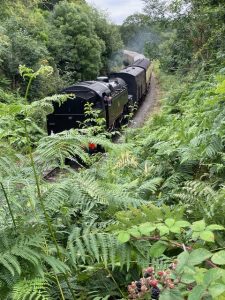

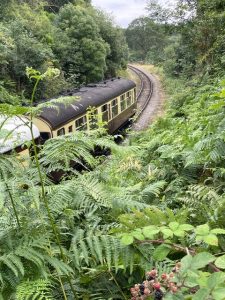
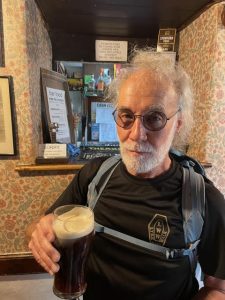
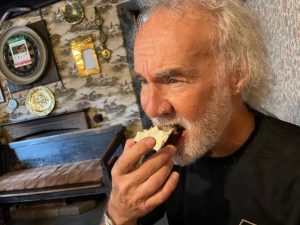
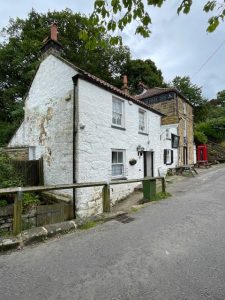
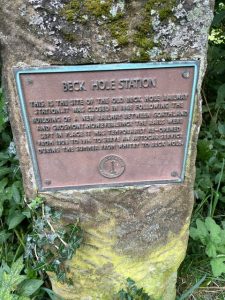
This was followed up by meeting up with Kate and a pint and a slice of their beer cake costing a miserly £12.50 showed that I had lost the plot in the singular experience of mortgaging my resting feet to those at Birch Hall Inn. (No credit card payments that day they were only accepting cash). It may be a 16th century inn and the interior has interest but the prices are 23rd century! Kate’s demeanour suggested the cost was too much to pay for the experience and opted out citing shock and general feelings of seeing beyond the hole in the wall which had the following notice stuck to it, only cash today.’ Onwards, with a change of sock on the right foot and replenishment of liquids, Kate sped off in her chariot and I had the unique experience of joining the old railway line and long lost platform below the pub at Beck Hole which serviced travellers and the movement of iron ore. Shortly after crossing the double span railway bridge I began the long gradual incline up to the Duckponds, mentioned again by Mr Cowley (he describes this route from west to east) but I chose not to swim or dabble my toes as I could see a window allowing me to claw back time regarding the 24hr challenge. Egton High Moor gives great views across to Bumble Wood and I wondered if anyone had been out painting the Blue Man? Was Matissa out there with her brush? From there I climbed up Wain Hill and stopped for a bite to eat, catch my breath and then off. What a beautiful surprise the entry into High Gill Beck at the northern point of Wintergill Plantation has to offer.
An orange carpet of pine needles stretched under my feet for the entirety of this section under a canopy of trees that blocked out 90% of light. Stunningly shocking to the senses and I was nearly seduced to stop and take root myself. This momentary pause to take in the varying colours of ferns (glassy, shiny green) against the orange carpet and the lack of light suggested that bewitching could easily take place in that place. And, then light came from the same grove as I proceeded through to Nab End. This is a lush area of farmland in a faraway place. Glaisdale became a spiritual paradise of greenery,
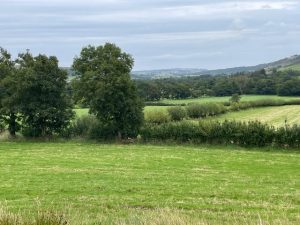
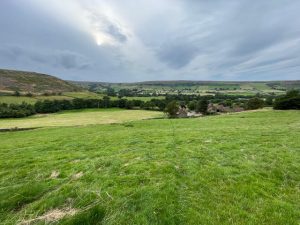
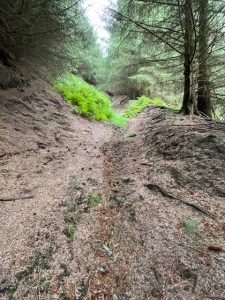
great views and calmness that is difficult to achieve in the present day world. Silence enveloped me further as I walked up Caper Hill walking towards the Cut Road Path and over Glaisdale High Moor. (Look back if you ever walk this way, Whitby and the sea beckon). I had found my paradise to equal that of Wainwright’s Lakes description on his first sight of them from Orrest Head. Apart from Beck Hole I had met no one all day and I am glad that I didn’t have to share the moments from crossing the moor and the richness of the greenery over Yew Grain Scar, hiding the workings of man’s past, part of the head wall to Great Fryup Dale.
I read later that, ‘the top part of the Scar is made up of ferruginous (iron bearing) sandstone, with fossiliferous and alum shale below.’ So, based on my observations of hummocks littering the landscape I presume that the lushness of the greenery now hides man’s past mining of the land here. No water tumbled over the cliffs but the breathtaking ethereal green colour palette has left a legacy in my memory as much as the earlier orange pine floor that I walked through. The Cut Road (Path) reminded me of previous Coast to Coast adventures and passing by the Trough House (a game keeper’s house) I called my partner suggesting a time we could meet at the Lion’s Inn in about an hour and a half’s time.
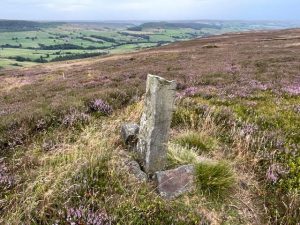
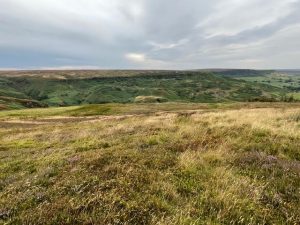
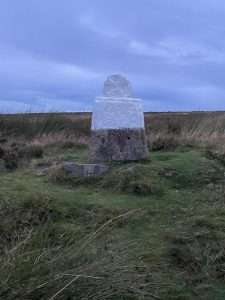
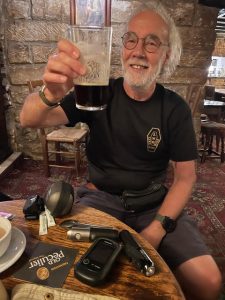
There is one thing about the Lion’s Inn night lights – Blackpool Illuminations have reached the moors. As an understatement it is well lit up. So, passing Fat Betty (which has had a new coat of paint) I continued to my next resting place, the inn. No Jam Roly Poly as the kitchen was closed! But, there was a pot of Earl Grey tea and a pint of Theakston’s Old P. Kate joined me here for a thirty minute break and to restock me with a good bacon butty, a fresh flask of peppermint tea and a bottle of Lucozade. Energy boosts for the nighttime trek. On emerging from the Inn it was belting it down (c10.30pm) and the waterproofs came out. I did think of a warm bed and realised that an assisted walk, although having its upside, also had temptations placed there by the devil himself and wished Kate a good night. She drove off in heavy rain and I sighed about the weather but knew I was going to complete the walk on time. I love (literally) walking from the Lion Inn along the old railway to Bloworth Crossing, Round Hill and to the seat above Hasty Bank. The sense of adventure, excitement and joy at walking in the dark alone and alongside stationary frogs held frozen in the head torches beam creates a sense of rapture that makes the LWW evoke memories of the past, present and future. My body alters into a canopy of shared landscape shadows and I passed into another existence until daybreak (c4.20am). It’s quite odd to note that morning light seems to rise so quickly. By c5am there was radiant sunlight which accompanied me for the rest of the walk. At that moment I become human again. But, this shared reality had a companion that night, that of extremely strong winds, which, gusted with bravo until I arrived at the Greenhow Plantation where I took a break. So, I took the decision of staying low and not going onto the cliffs up to the Wain Stones from Hasty Bank but remained low on rather a muddy track, ‘the old jet miner’s track,’ (Cowley, 1971, pg. 24) through to Green Bank and then (and this seems to occur at daybreak) the gusts of wind had significantly reduced and I began the climb up to the top of Carlton Moor
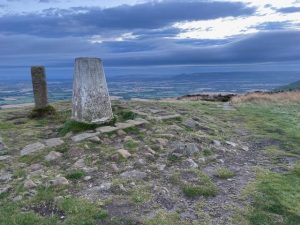
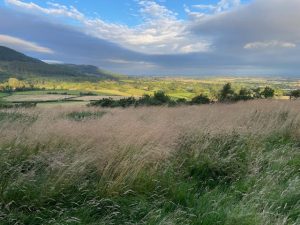
(what views and only dying breaths of wind) and eventually the Bronze Age Cairn down to what has become my pilgrimage stop above Hollin Hill where there is a decent seat, peace and quiet and the final stretch through Clain Wood (no owl hoots at this stage of the day). At the farm below Hollins Hill I came across Scottish Highland Cattle, calves with mums and dad, straddling the path as I walked in between them. Their horns looked dangerous but the cattle were quite impervious to human presence, enjoying the grass and being an extended family. Who is this human I heard mooed.
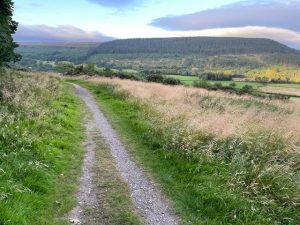

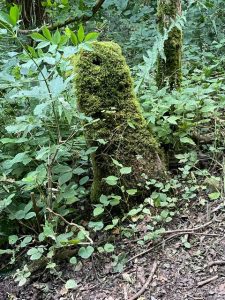
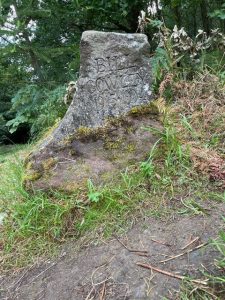
The memorial to Bill Cowley awaited me close to the exit on the road (someone has been out with a strimmer) easier to see than before. And, literally the job was a done deal and another crossing completed. A slow walk down to Osmotherley bus stop followed where I awaited Kate picking me up. A great walk with some time to spare.
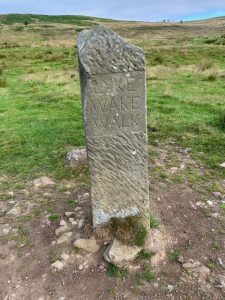
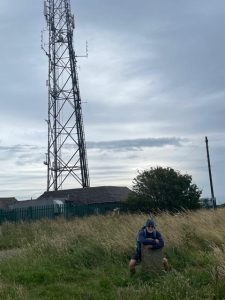
Well. ther’ your go!
I’m walking the LWW again next Monday 19, so a further report to follow then.